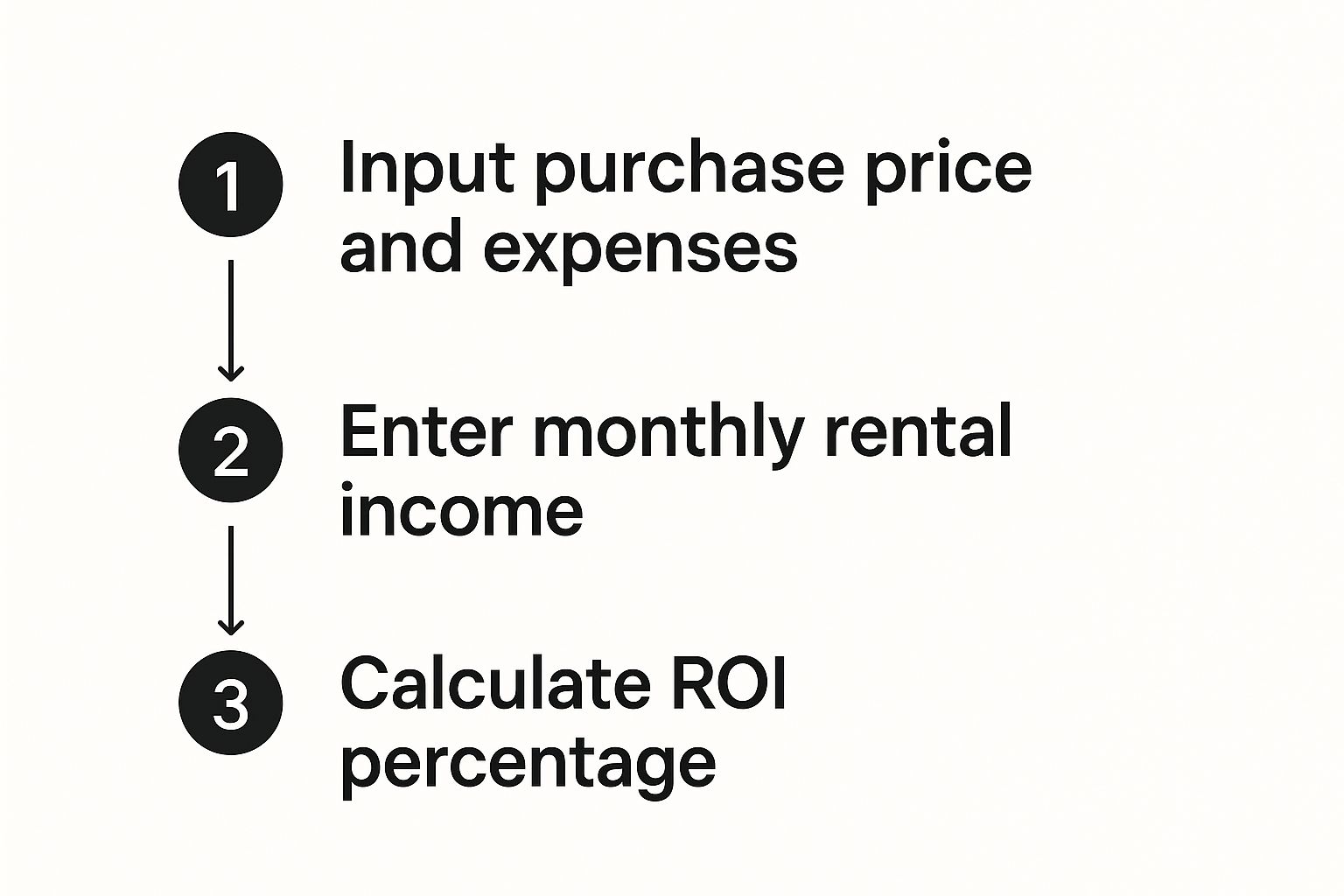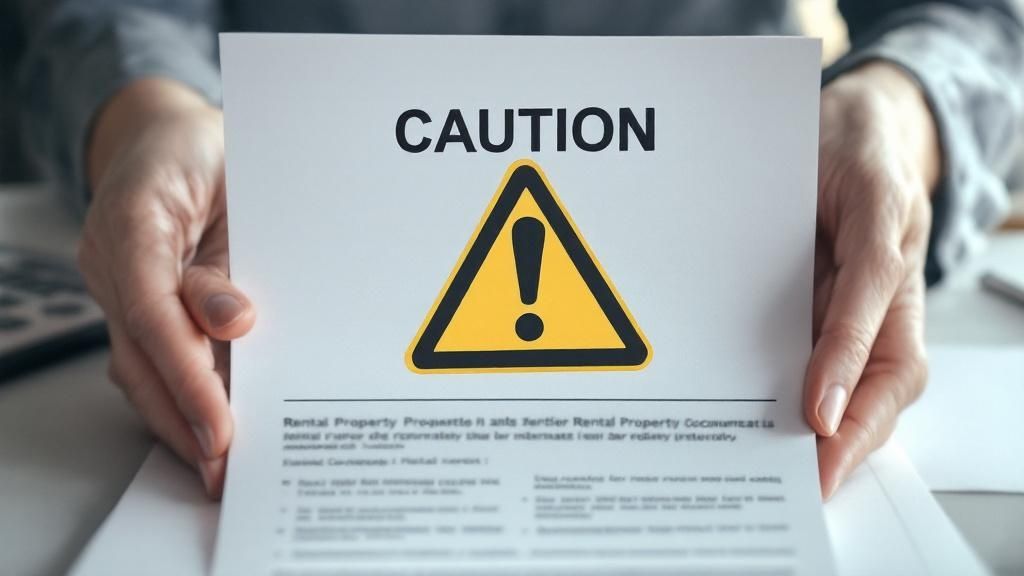Rental Property ROI Calculator to Maximize Your San Diego Investment
- Mark Palmiere

- Aug 21
- 10 min read
TL;DR
What it is: A rental property ROI calculator is an essential tool to measure the profitability of your investment by comparing your financial return against your total cash invested.
Key Formulas: The two most important metrics are the Capitalization Rate (Cap Rate) for comparing properties and the Cash-on-Cash Return for understanding the performance of your personal investment.
Essential Inputs: To get an accurate calculation, you must include all costs: purchase price, closing costs, repairs, furnishings, property taxes, insurance, maintenance, and a budget for vacancy (5-10%).
How to Boost ROI: Strategic upgrades (modern finishes, smart tech), professional management, and smarter financing can significantly increase your returns. A hybrid Short-Term (STR) and Mid-Term (MTR) strategy is key for year-round income.
Common Mistakes: Avoid underestimating operating expenses, forgetting to budget for vacancy and major capital expenditures (CapEx), and relying on gross rent instead of Net Operating Income (NOI).
Figuring out your rental property's Return on Investment (ROI) is probably the single most important thing you can do to understand if it's actually making you money. A good rental property ROI calculator takes the guesswork out of the equation and gives you a clear percentage showing your financial return against what you put in. For San Diego property owners, this number is your compass—it’s what guides smart, data-driven decisions that lead to higher profits. With a partner like West Coast HomeStays, you can turn those numbers into a hands-off, high-revenue reality.
Your Quick Guide to Calculating Rental Property ROI
Before you start plugging numbers into a calculator, it helps to know what you're actually measuring. ROI isn't just one simple number; it's a story told through a few different financial lenses. For any real estate investor, two of the most critical formulas to master are the Capitalization Rate and the Cash-on-Cash Return. Each one gives you a unique, coastal-cool angle on your property's performance.

Key Formulas to Know
Capitalization Rate (Cap Rate): Think of this as a quick health check for a property's profitability. It’s perfect for comparing potential investments in the same market because it measures the Net Operating Income (NOI) against the property's purchase price, completely ignoring any financing details.
Cash-on-Cash Return: This formula is much more personal. It calculates your annual pre-tax cash flow as a percentage of the total cash you actually invested out-of-pocket. This is the one that tells you how hard your own money is working for you.
To get a truly accurate result from any rental property ROI calculator, you need to be precise with your data. This means everything from the purchase price and closing costs to all the ongoing operational expenses—think taxes, insurance, maintenance, and management fees.
And if you're working with larger properties, you'll definitely want to use a dedicated tool like a multifamily investment calculator to keep your numbers straight.
Gathering Your Numbers for an Accurate ROI Calculation
Any rental property ROI calculator is a powerful tool, but it’s only as good as the numbers you feed it. To get a true picture of your investment's health, you have to dig deeper than just the purchase price and monthly rent.
A detailed, honest-to-goodness assessment of all your expenses is what separates a hopeful guess from a solid financial forecast.
Beyond the Purchase Price
Your initial investment is way more than just the sticker price. It’s absolutely crucial to tally up every single dollar you spent just to get the property ready for its first guest.
Closing Costs: These usually land somewhere between 2% to 5% of the home's purchase price. Think appraisal fees, title insurance, loan origination, and all that fun stuff.
Initial Repairs & Upgrades: Did you have to slap on a new coat of paint, replace the tired-looking flooring, or give a bathroom a much-needed facelift before listing? All of those costs are part of your initial stake.
Furnishings & Staging: For a vacation rental, this is a big one. It's a significant expense that directly impacts your nightly rate and, more importantly, the guest experience.
Accounting for Ongoing Operating Expenses
Once your property is up and running, the costs don't just stop. These are the recurring expenses that eat into your net operating income, and they must be factored into any rental property ROI calculator. Glazing over them will give you a dangerously rosy—and completely inaccurate—financial picture.
Forgetting to budget for vacancy is one of the biggest mistakes new investors make. Even in a hot market like San Diego, assuming 100% occupancy year-round isn't realistic. A conservative estimate is to budget for a 5-10% vacancy rate.
To help you get organized, here’s a quick checklist of the essential income and expense items you’ll need.
Essential Inputs for Your ROI Calculator
Category | Data Point | Example (San Diego Property) |
|---|---|---|
Initial Investment | Purchase Price & Closing Costs | $750,000 + $22,500 (3%) |
Repairs & Upgrades | $15,000 for new flooring & paint | |
Furnishings & Staging | $20,000 | |
Income | Gross Annual Rent | $84,000 ($7,000/month) |
Other Income (cleaning fees, etc.) | $3,600 | |
Operating Expenses | Property Taxes | $9,375 (1.25% of purchase price) |
Homeowners Insurance | $1,200 | |
Utilities (if applicable) | $2,400 | |
Maintenance & Repairs | $7,500 (1% of property value) | |
Property Management Fees | $8,400 (10% of gross rent) | |
HOA Fees | $3,000 | |
Vacancy Loss | $4,200 (5% of gross rent) |
Putting in the effort to track these numbers meticulously ensures your ROI calculation is firmly grounded in reality, not just wishful thinking.
For specific strategies on how to boost returns in competitive coastal markets, check out our guide on [Carlsbad property management](https://www.westcoasthomestays.com/post/carlsbad-property-management-guide-to-maximize-your-roi).
Putting the Key ROI Formulas into Practice
Once you have your numbers wrangled, it's time to put them to work. The two formulas I lean on most are the Capitalization Rate (or Cap Rate) and the Cash-on-Cash Return. Each gives you a different, but equally valuable, snapshot of your property's financial health.
Think of it this way: Cap Rate is your 10,000-foot view. It’s perfect for quickly comparing different properties in the same market, like an apples-to-apples gut check. Cash-on-Cash Return, on the other hand, gets personal. It shows you exactly how well your specific investment is performing based on the actual cash you put in.
Calculating Capitalization Rate (Cap Rate)
The Cap Rate formula is refreshingly simple: Net Operating Income (NOI) / Property Purchase Price = Cap Rate.
It’s a back-of-the-napkin metric that tells you how profitable a property is before you even think about financing. A higher Cap Rate is generally a good sign, suggesting a better return relative to the property's cost.
For a real-world example, let's say you're looking at a property in San Diego with a Net Operating Income of $45,000 and a purchase price of $900,000. Your Cap Rate would be 5%. This number is your baseline, allowing you to quickly size up its potential against other local deals.
This visual guide breaks down the process into three simple stages for any rental property ROI calculator.

As you can see, the whole process hinges on getting those income and expense inputs right. Garbage in, garbage out.
Drilling Down with Cash-on-Cash Return
When you’re ready to see how your own money is performing, the Cash-on-Cash Return formula is what you need: Annual Pre-Tax Cash Flow / Total Cash Invested = Cash-on-Cash Return.
This is the number that really matters to most investors because it measures the return on the actual dollars that left your bank account.
Let's say your total cash investment—covering the down payment, closing costs, and some initial repairs—was $200,000. If your annual cash flow after paying the mortgage and all other expenses is $16,000, your Cash-on-Cash Return is a solid 8%. This metric is crucial for understanding how leverage is working for you and hitting your personal [passive income goals in San Diego](https://www.westcoasthomestays.com/post/how-to-earn-passive-income-from-rental-property-in-san-diego).
Knowing how to run these numbers is more important than ever. With the property management sector projected to grow from $24.18 billion in 2024 to $52.21 billion by 2032, it's clear that investor confidence is strong. Precise calculations are what separate the pros from the amateurs.
While we're focused on rental properties here, the core concepts apply to all sorts of investments. For a deeper dive into the [general principles of calculating Return on Investment (ROI)](https://blog.investogy.com/how-to-calculate-return-on-investment/), this guide is a fantastic resource.
Actionable Strategies to Actively Boost Your ROI
An ROI calculator is a great starting point—it gives you a snapshot of where your property stands today. But the real money is made when you move beyond the numbers and actively work to unlock your property's future potential.
Turning a good investment into a great one often comes down to a few smart, tangible moves.

Just look at the design-forward approach in the photo above. Thoughtful aesthetics and modern amenities aren't just nice perks anymore; they're essential for attracting the kind of high-quality guests who are happy to pay a premium.
Strategic Upgrades and Professional Management
Targeted property improvements are one of the most direct ways to bump up your income. You don't need a full gut renovation, either. Small changes can deliver surprisingly big results.
Modern Finishes: Think about upgrading kitchen countertops, swapping out dated light fixtures, or installing a stylish backsplash. These touches can completely elevate the feel of a space.
Smart Home Tech: Today's travelers expect conveniences like keyless entry, smart thermostats, and reliable high-speed Wi-Fi. These aren't just features; they're baseline expectations.
Curb Appeal: Never underestimate a first impression. A fresh coat of paint and some well-maintained landscaping create an immediate sense of quality that justifies a higher price point.
But honestly, the single most impactful financial move you can make is often partnering with an expert property manager.
🌟 Spotlight on West Coast HomeStays✔ 20–30% revenue boost✔ Hybrid STR + MTR strategy✔ Five-star guest experiences👉 [Book a strategy call](https://www.westcoasthomestays.com)
By adopting a hybrid Short-Term (STR) and Mid-Term Rental (MTR) model, owners can significantly reduce vacancy rates. This strategy combines high-revenue vacation bookings with stable, longer-term corporate or military stays, ensuring consistent cash flow all year.
Smarter Financing and Long-Term Growth
Your financing structure also plays a huge role in your final ROI. To get the best terms and maximize what you take home, it’s always a good idea to work with an experienced investment property mortgage broker who really understands the ins and outs of investor loans.
When you combine smart upgrades, expert management, and optimized financing, you're no longer just a passive owner—you're actively shaping your property's profitability.
To dive deeper, check out these [10 rental property investment strategies](https://www.westcoasthomestays.com/post/10-rental-property-investment-strategies-to-maximize-your-san-diego-income) we've put together specifically for maximizing income in the competitive San Diego market.
Common Mistakes to Avoid When Calculating Rental ROI
A rental property ROI calculator is a fantastic tool, but it's only as good as the numbers you feed it. I've seen a few common slip-ups turn a confident forecast into a costly miscalculation time and time again. Avoiding these is absolutely crucial if you want to make investment decisions grounded in reality, not just wishful thinking.

By far, the most frequent error is underestimating your operating expenses. It's easy to get excited by the potential gross rent and gloss over the less glamorous costs that steadily chip away at your actual profit.
These aren't just minor details; they are the financial bedrock of your investment. Overlooking them creates a dangerously inflated ROI figure that won't survive its first contact with the real world. Many of these issues are universal, which is why we put together a guide on the most costly mistakes San Diego vacation rental owners make.
Forgetting About Vacancy and Capital Expenditures
Even in a hot market like San Diego, assuming your property will be 100% occupied is a recipe for disappointment. Smart investors always build in a vacancy buffer—typically 5-10% of the gross annual rent—right into their calculations.
Another major oversight is failing to plan for Capital Expenditures (CapEx). These are the big-ticket items that don't hit every year but can absolutely wipe out your cash flow when they do.
We’re talking about things like:
A new roof that can run into the thousands.
An HVAC system failure right in the middle of summer.
Major appliance replacements like refrigerators or water heaters, which all have a finite lifespan.
Setting aside a separate fund for CapEx (I usually recommend 1-2% of the property's value annually) ensures you’re prepared for these inevitable costs instead of being blindsided by them.
Relying on gross rent instead of Net Operating Income (NOI) is another classic mistake. Gross rent is a vanity metric; NOI is a sanity metric. It reflects your true income after all operational costs are paid.
Understanding these variables is also key when you start looking at global markets. For instance, some countries offer incredibly high rental yields. South Africa leads with an estimated gross rental yield of 10.15%, while Latvia and Ireland follow with strong returns of 8.06% and 7.85%, respectively. It's tempting to jump on those numbers, but as these global property insights highlight, accurate expense tracking is what separates a good investment from a bad one, no matter where you are in the world.
Frequently Asked Questions About San Diego Rental Management
We get a lot of great questions from San Diego property owners trying to wrap their heads around ROI and how to get the most out of their rentals. Here are some of the most common ones we answer.
What makes West Coast HomeStays different from other managers?
Our key difference is a data-driven, boutique approach. We combine a powerful hybrid STR + MTR strategy with five-star hospitality and design-forward presentation. This isn't a one-size-fits-all model; it's a personalized plan that consistently boosts owner revenue by an average of 20-30% while keeping the process completely hands-off for you.
Can you handle both short- and mid-term stays?
Absolutely—it's our specialty. Our hybrid strategy is designed to maximize your income by blending high-revenue short-term vacation bookings with stable, longer-term corporate or military stays. This flexibility allows us to keep your calendar full and your income steady all year, adapting to seasonal demand in the San Diego market.
How quickly can my listing be optimized?
We move fast. Our onboarding process is designed to make an impact right away. After an initial property assessment, we handle strategic design tweaks, professional photography, and SEO-rich listing copy. Most of our partner properties are fully optimized and live on major booking platforms within just 2-4 weeks, ready to attract premium guests.
What amenities do your San Diego homes include?
Our homes are packed with amenities that attract top-tier guests. This typically includes outdoor living spaces (patios, fire pits), family-friendly features (high chairs, beach gear), dedicated workspaces with high-speed Wi-Fi, and modern comforts like air conditioning, smart TVs, and keyless entry. We focus on creating a complete, five-star experience.
Do you help with design upgrades to boost nightly rates?
Yes, this is a core part of our service. We offer expert design consulting to identify the most cost-effective upgrades that will deliver the biggest boost to your ROI. From a fresh coat of paint and modern fixtures to a full furnishing and staging project, we ensure your property stands out and commands its maximum potential nightly rate.
If you’re ready for truly hands-off, higher-earning rentals in San Diego, West Coast HomeStays is the partner to trust.


Comments